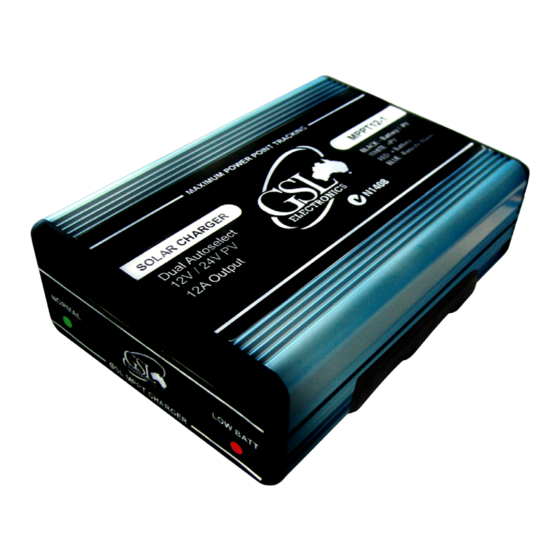Advertisement
Quick Links
Model:
BMPPT-150
Page 1 of 8
This revolutionary maximum power point tracker solar charger
was designed using the technology that won GSL Electronics the
prestigious "2008 EDN Innovation award". A simple, compact,
low cost and highly efficient way to charge sealed or vented 24V
batteries from low voltage or parallel panels with built in Low
Voltage Disconnect, Load Remote Control or Dusk to Dawn mode.
Efficiency Typical
Input Voltage
Output Voltage (Float)
Output Voltage (Bulk)
Output Power
Quiescent Current
Thermal Protection
Dimensions (mm)
Indications
Booster Maximum Power Point Tracker
Please read these instructions before use
PATENT APPLIED FOR - 2010901565
BMPPT-150 Specifications
150W @ V
Dual LED display – battery OK / LOW
Unit 2, 110 Station Road, Seven Hills ,NSW, 2147, Australia
150W Solar Charger
Operating Instructions
BMPPT - 150 Unit
95%
14V to 54V
27V / 54V
(See NOTE on Pg.2)
Flooded 29V, Sealed 28.4V
/ V
≈ 2 , 100W @ V
out
in
0.04A
Multilevel type
35 X 75 X 100mm
/ V
≈ 4
out
in
BMPPT-150-R4
Advertisement

Summary of Contents for GSL electronics BMPPT-150
- Page 1 Please read these instructions before use This revolutionary maximum power point tracker solar charger was designed using the technology that won GSL Electronics the prestigious “2008 EDN Innovation award”. A simple, compact, low cost and highly efficient way to charge sealed or vented 24V batteries from low voltage or parallel panels with built in Low Voltage Disconnect, Load Remote Control or Dusk to Dawn mode.
-
Page 2: Important Notes
• Before connecting battery always check battery and PV panel polarity. • If used with panels over 150W the BMPPT-150 MUST be fitted with the PVF fuse. Locate this fuse as close as possible to the BMPPT. A 10A 32V fuse is recommended. - Page 3 Please read these instructions before use Settings And Configurations: The BMPPT-150 factory default setting is for sealed lead acid batteries (Maximum charge voltage 28.4V and float voltage 27V) and auxiliary switch (grey wire) configured in Low Voltage Disconnect mode. The various operating modes can be configured with a combination of the green and yellow wires and the internal links CHE and REN.
- Page 4 Model: 150W Solar Charger BMPPT-150 Booster Maximum Power Point Tracker Page 4 of 8 Operating Instructions Please read these instructions before use Wiring With Dawn To Dusk Switch: The DDS option is intended to power up loads during night-time only.
- Page 5 Model: 150W Solar Charger BMPPT-150 Booster Maximum Power Point Tracker Page 5 of 8 Operating Instructions Please read these instructions before use Wiring With Low Voltage Disconnect : The LVD option disconnects the load when the battery voltage drops below 0.85 of nominal voltage to protect the battery from damage.
- Page 6 Model: 150W Solar Charger BMPPT-150 Booster Maximum Power Point Tracker Page 6 of 8 Operating Instructions Please read these instructions before use Wiring With Critical And Non Critical Loads: Critical loads are generally light loads which are powered under any condition. Non critical loads are loads which can be disconnected to ensure maximum on time for critical loads as well as to extend the life expectancy and reliability of the system.
- Page 7 Model: 150W Solar Charger BMPPT-150 Booster Maximum Power Point Tracker Page 7 of 8 Operating Instructions Please read these instructions before use Wiring The Remote Alarm: The remote alarm is a normally low, 5V digital signal that goes high when the battery voltage drops below 0.9 of nominal voltage, the LVD disconnects or over temperature trips.
- Page 8 Q: What is the smallest panel size for the BMPPT-150? The smallest panel size recommended for the BMPPT-150 is 10W, below that level the BMPPT will not function effectively. Q: Is interference possible? and If so what do I do? GSL’s BMPPTs produce far less interference than conventional solar regulator during the absorption and float stages, that...












Need help?
Do you have a question about the BMPPT-150 and is the answer not in the manual?
Questions and answers